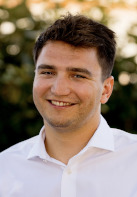 Romain Feigean is a researcher at the Neuromuscular Physiology and Evaluation Laboratory headed by Jean-Yves Hogrel at the Institute’s NIC. He is particularly involved in assessing motor function, and more specifically walking, a project for which he has been awarded a grant from the Rare Diseases Foundation*. Interview
Romain Feigean is a researcher at the Neuromuscular Physiology and Evaluation Laboratory headed by Jean-Yves Hogrel at the Institute’s NIC. He is particularly involved in assessing motor function, and more specifically walking, a project for which he has been awarded a grant from the Rare Diseases Foundation*. Interview
How will you be working on gait assessment?
We are starting from the idea that if we can better understand how patients walk, it will be possible to improve the quality of assistance (intensity and timing of assistance) and the comfort of exoskeletons so that they are better suited to individuals.
This involves understanding the neuromuscular biomechanics of walking, i.e. assessing movement in a three-dimensional plane, and muscle activity and behaviour.
We are currently developing a smartphone tool called AIgait, intended for doctors and healthcare professionals. Based on a simple video of a patient walking, artificial intelligence and our expertise in movement analysis, the tool is able to provide metrics (key indicators) that characterise the impairment of locomotor function.
What are the factors evaluated?
Kinematics are assessed, i.e. movement and joint ranges of motion (hip, knee, ankle), as well as parameters relating to time and space. Building on our previous work, we are seeking to make it possible to measure the factors that determine the decline in performance in people with neuromuscular diseases (stride length, duration and cadence, foot angle when it touches the ground, hip joint range of motion, etc.).
More specifically, which part of the project will the master student you are recruiting be involved in?
The first part concerns measurement in the sagittal plane and in tracking shots: we will film the person walking from the side and follow them over a certain distance. This is the initial project that will soon be validated in a clinical trial.
In the second part, which is more focused on methodological development, the aim is to quantify walking deficits in a frontal plane, again using video (filming either from behind or from the front). This is where the master student, whose scholarship is funded by the Rare Diseases Foundation, will come in.
For the third part, which, if all goes well, the student will be able to take care of, the aim is to use it to assess the deterioration of walking in Pompe disease by calculating the same metrics obtained with an accelerometer, which are traditionally measured in therapeutic trials or natural history studies.
Our application will then provide an accurate characterisation of gait quality. The idea is to offer a simplified solution for measuring gait in order to better quantify deterioration during assessments, without patients having to wear a measuring device.
What are the prospects?
Over the next six months, we will develop the front-end of the tool. It will then need to be scientifically validated in a clinical trial conducted in collaboration with the Neuro-Myology Department for participant recruitment.
For patients, this will eventually enable them to carry out their assessment at home by simply placing a smartphone on a tripod to film themselves walking back and forth.
It is conceivable that, after a few modifications, particularly with regard to the key determinants to be observed, this tool could be used in the context of diseases involving gait impairment, outside the field of neuromuscular diseases, in post-stroke patients, Parkinson’s patients or in the context of rehabilitation follow-up, for example.
_____
* Call for proposals: ‘Innovation in AI and e-health for rare diseases’
